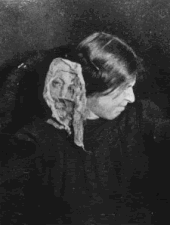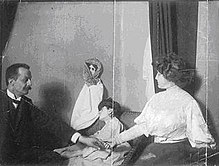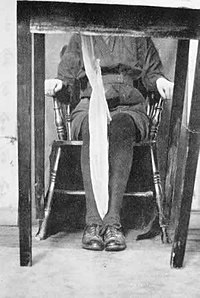Ectoplasm (paranormal)
| Part of a series on the |
| Paranormal |
|---|
In spiritualism, ectoplasm, also known as simply ecto, a substance or spiritual energy "exteriorized" by physical mediums. It was coined in 1894 by psychical researcher Charles Richet.[1] Although the term is widespread in popular culture,[2] there is no scientific evidence that ectoplasm exists[3][4][5][6] and many purported examples were exposed as hoaxes fashioned from cheesecloth, gauze or other natural substances.[7][8]
The term comes from the Ancient Greek words ἐκτός ektos, "outside" and πλάσμα plasma, "anything formed".
Phenomenon
In Spiritualism, ectoplasm is said to be formed by physical mediums when in a trance state. This material is excreted as a gauze-like substance from orifices on the medium's body and spiritual entities are said to drape this substance over their nonphysical body, enabling them to interact in the physical and real universe. Some accounts claim that ectoplasm begins clear and almost invisible, but darkens and becomes visible as the psychic energy becomes stronger. Still other accounts state that in extreme cases ectoplasm will develop a strong odor. According to some mediums, the ectoplasm cannot occur in light conditions as the ectoplasmic substance would disintegrate.[9]
The psychical researcher Gustav Geley defined ectoplasm as being "very variable in appearance, being sometimes vaporous, sometimes a plastic paste, sometimes a bundle of fine threads, or a membrane with swellings or fringes, or a fine fabric-like tissue".[10] Arthur Conan Doyle described ectoplasm as "a viscous, gelatinous substance which appeared to differ from every known form of matter in that it could solidify and be used for material purposes".[11]
The physical existence of ectoplasm has not been scientifically demonstrated, and tested samples purported to be ectoplasm have been found to be various non-paranormal substances.[4][12] Other researchers have duplicated, with non-supernatural materials, the photographic effects sometimes said to prove the existence of ectoplasm.[13]
Ectenic force

The idea of ectoplasm was merged into the notion of an "ectenic force" by some early psychical researchers who were seeking a physical explanation for reports of
Other psychical researchers who studied mediumship speculated that within the human body an unidentified
The psychical investigator W. J. Crawford (1881–1920) had claimed that a fluid substance was responsible for
The physicist and psychical researcher Edmund Edward Fournier d'Albe later investigated the medium Kathleen Goligher at many sittings and arrived at the opposite conclusions to Crawford; according to D'Albe, no paranormal phenomena such as levitation had occurred with Goligher and stated he had found evidence of fraud. D'Albe claimed the substance in the photographs of Crawford was ordinary muslin.[22][23] During a séance D'Albe had observed white muslin between Goligher's feet.[24]
Fraud


Ectoplasm on many occasions has been proven to be fraudulent. Many mediums had used methods of swallowing and regurgitating cheesecloth, textile products smoothed with potato starch and in other cases the ectoplasm was made from paper, cloth and egg white or butter muslin.[25][26][27][28]
The Society for Psychical Research investigations into mediumship exposed many fraudulent mediums which contributed to the decline of interest in physical mediumship.[29] In 1907, Hereward Carrington exposed the tricks of fraudulent mediums such as those used in slate-writing, table-turning, trumpet mediumship, materializations, sealed-letter reading and spirit photography.[30]
In the early 20th century the psychical researcher Albert von Schrenck-Notzing investigated medium Eva Carrière and claimed her ectoplasm "materializations" were not from spirits but the result of "ideoplasty" in which the medium could form images onto ectoplasm from her mind.[31] Schrenck-Notzing published the book Phenomena of Materialisation (1923) which included photographs of the ectoplasm. Critics pointed out the photographs of the ectoplasm revealed marks of magazine cut-outs, pins and a piece of string.[32] Schrenck-Notzing admitted that on several occasions Carrière deceptively smuggled pins into the séance room.[32] Magician Carlos María de Heredia replicated Carrière's ectoplasm using a comb, gauze and a handkerchief.[32]
Donald West wrote that the ectoplasm of Carrière was fake and was made of cut-out paper faces from newspapers and magazines on which fold marks could sometimes be seen from the photographs. A photograph of Carrière taken from the back of the ectoplasm face revealed it to be made from a magazine cut out with the letters "Le Miro". The two-dimensional face had been clipped from the French magazine Le Miroir.[33] Back issues of the magazine also matched some of Carrière's ectoplasm faces.[34] Cut out faces that she used included Woodrow Wilson, King Ferdinand of Bulgaria, French president Raymond Poincaré and the actress Mona Delza.[35]

After Schrenck-Notzing discovered Carrière had taken her ectoplasm faces from the magazine he defended her by claiming she had read the magazine but her memory had recalled the images and they had materialized into the ectoplasm.[31] Because of this Schrenck-Notzing was described as credulous.[32] Joseph McCabe wrote "In Germany and Austria, Baron von Schrenck-Notzing is the laughing-stock of his medical colleagues."[36]
Danish medium Einer Nielsen was investigated by a committee from the Kristiania University in Norway in 1922 and it was discovered in a séance that his ectoplasm was fake.[37] He was also caught hiding ectoplasm in his rectum.[38] Mina Crandon was a famous medium known for producing ectoplasm during her séance sittings. She produced a small ectoplasmic hand from her stomach which waved about in the darkness. Her career ended, however, when biologists examined the hand and found it to be made of a piece of carved animal liver.[39] Walter Franklin Prince described the Crandon case as "the most ingenious, persistent, and fantastic complex of fraud in the history of psychic research".[40]
Psychical researchers Eric Dingwall and Harry Price republished an anonymous work by a former medium, entitled Revelations of a Spirit Medium (1922), which exposed the tricks of mediumship and the fraudulent methods of producing "spirit hands".[41] Originally all the copies of the book were bought up by spiritualists and destroyed.[42] On the subject of ectoplasm and fraud, John Ryan Haule wrote:
Because ectoplasm was believed susceptible to destruction by light, the possibility that ectoplasm might appear became a reason for making sure that Victorian séances took place in near darkness. Poor lighting conditions also became an opportunity for fraud, particularly as faux ectoplasm was easy to make with a mixture of soap, gelatin and egg white, or perhaps merely well-placed muslin.[43]
Psychical researcher Harry Price exposed medium Helen Duncan's fraudulent techniques by proving, through analysis of a sample of ectoplasm produced by Duncan, that it was cheesecloth that she had swallowed and regurgitated.[44] Duncan had also used dolls' heads and masks as ectoplasm.[45] Mediums would also cut pictures from magazines and stick them to the cheesecloth to pretend they were spirits of the dead.[46] Another researcher, C. D. Broad, wrote that ectoplasm in many cases had proven to be composed of home material such as butter-muslin, and that there was no solid evidence that it had anything to do with spirits.[47]
Photographs taken by
In popular culture
Since its release in 1984, the film Ghostbusters has popularized in contemporary fiction the idea of associating ghosts with slimy, often green, ectoplasm.
In the 1937 Cary Grant movie Topper, ectoplasm is the means whereby the ghosts George and Marian Kirby make themselves visible.
See also
- Spirit photography
- Aura (paranormal)
- Bhoot (ghost)
- Ghost
- Ichor
- Incorporeal
- Kirlian photography
- List of basic parapsychology topics
References
- ISBN 978-1-4419-1222-0
- ISBN 978-0-313-27523-4.
- ISBN 978-1-4408-3491-2.
- ^ ISBN 1-57392-161-0.
- ^ "Ectoplasm" Archived 2011-01-11 at the Wayback Machine. Glossary of Key Words Frequently Used in Parapsychology, Parapsychological Association (2006-01-24).
- ISBN 978-1-61592-085-3.
- ISBN 0-8103-8414-0.
One strange phenomena of spiritualism, once popular, was the production of ectoplasm. This was a white substance that appeared to ooze from various openings of the medium's body. It was usually made of gauze, chiffon, or cheesecloth, often soaked or treated with various substances.
- ISBN 978-1-61592-594-0.
- ISBN 978-1-4179-9107-5.
- ASIN B000JR9R8K.
- ISBN 978-0-8094-8075-3.
- ISBN 0-87975-729-9.
- ^ Peterson, Dawn M. (June 2004). "Mysterious Beings or Mere Accidents?". Skeptical Briefs.
- ASIN B000ORMS8Q.
- Blavatsky H. P."Isis Unveiled: A Master-Key to the Mysteries of Ancient and Modern Science and Theology", Theosophical University Press
- ^ Randi, James (n.d.) [1995 (print)]. "Psychokinesis". An Encyclopedia of Claims, Frauds, and Hoaxes of the Occult and Supernatural. Digital adaptation by Gilles-Maurice de Schryver. (Online ed.). James Randi Educational Foundation [St. Martin's Press (print)]. Retrieved 26 January 2022. (Note, the entry Ectonic force refers the reader to Psychokinesis.)
- ^ Hamlin Garland. (1936). Forty years of psychic research: a plain narrative of fact. pp. 127–128
- ^ Lewis Spence. (2003). An Encyclopaedia of Occultism. p. 133
- ^ H. F. Prevost Battersby. (1988). Psychic Certainties. Kessinger Reprint Edition. pp. 125–126
- ^ Hereward Carrington. (2003). Eusapia Palladino and Her Phenomena. Kessinger Reprint Edition. p. 267
- ^ Bernard M. L. Ernst, Hereward Carrington. (2003). Houdini and Conan Doyle: The Story of a Strange Friendship. Kessinger Reprint Edition. p. 67
- ^ Julian Franklyn. (2005). A Survey of the Occult. p. 383
- ISBN 978-0-7123-4899-7
- ^ Edmund Edward Fournier d'Albe. (1922). The Goligher Circle. J. M. Watkins. p. 37
- ISBN 978-0-684-16181-5
- ISBN 978-0-356-07875-5"The most usual material for 'ectoplasm' however, seemed to be butter muslin or cheesecloth, probably swallowed and regurgitated."
- ISBN 978-0-85112-748-4"Fraudulent mediums were known to produce ectoplasm composed of nothing more than strips of muslin, or mixtures of soap, gelatin and egg white."
- ISBN 1-57607-654-7
- ISBN 978-0-85112-748-4
- ^ Hereward Carrington (1907). The Physical Phenomena of Spiritualism. Herbert B. Turner & Co.
- ^ ISBN 978-0-252-07751-7
- ^ a b c d Carlos María de Heredia (1922). Spiritism and Common Sense. P. J. Kenedy & Sons. pp. 186–198
- ^ Donald West (1954). Psychical Research Today. Chapter Séance-Room Phenomena. Duckworth. p. 49
- ^ Georgess McHargue (1972). Facts, Frauds, and Phantasms: A Survey of the Spiritualist Movement. Doubleday. p. 187
- ISBN 978-1-57392-021-6
- ISBN 978-0-87975-828-8
- ^ Universitetskomiteen, Mediet Einer Nielsen, kontrolundersøkelser av universitetskomiteen i Kristiania (Kristiania 1922). "Rapport fra den av Norsk Selskab for Psykisk Forskning nedsatte Kontrolkomité". Norsk Tidsskrift for Psykisk Forskning 1 (1921–22).
- ISBN 978-0-252-07751-7
- ISBN 9780738722214.
- ISBN 978-0-87975-533-1
- ^ Eric Dingwall, Harry Price (1922). Revelations of a Spirit Medium. Kegan Paul, Trench, Trübner & Co.
- ISBN 978-0-385-05305-1
- ISBN 0-203-83360-0
- ISBN 978-0-19-923923-8
- ISBN 0-87975-300-5
- ISBN 978-0-948403-55-2
- ^ C. D. Broad (2011). Lectures on Psychical Research. Reprint Edition. p. 304
- ^ Jokinen, Tom. "Touching the Dead: Spooky Winnipeg". Hazlitt. Random House. Archived from the original on 2013-12-03. Retrieved 2013-02-03.
- ISBN 978-0-912328-98-0
- ISBN 978-1-57859-209-8
